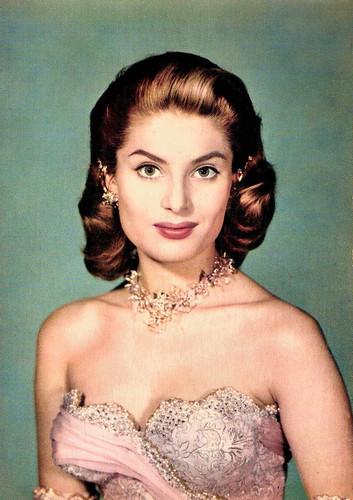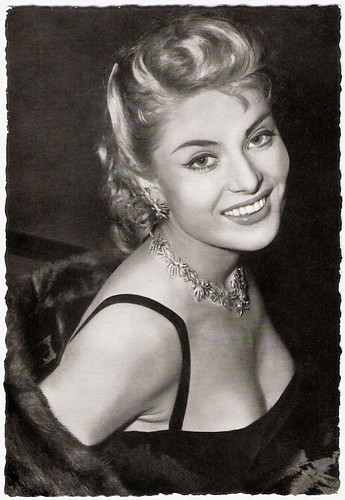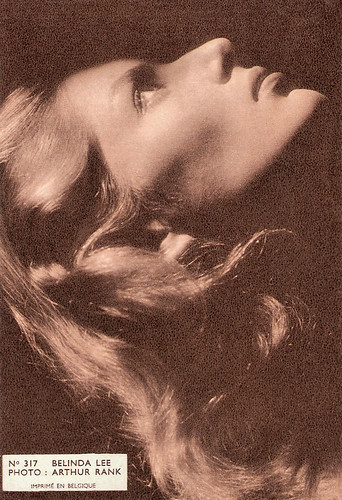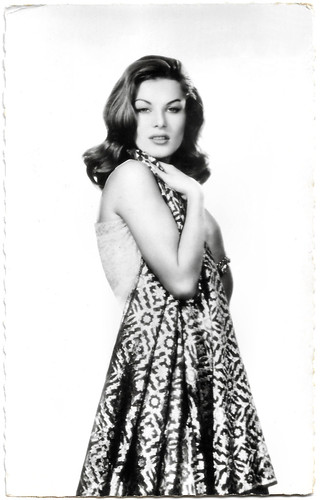
French postcard by Editions P.I., Paris, no. 1003. Photo: Sam Lévin.

German postcard by Kunst und Bild, Berlin-Charlottenburg, no. C D 21. Photo: Rank-Film.

Belgian card by Cox, no. 20.

German postcard by Ufa, Berlin-Tempelhof, no. CK-309. Photo: Klaus Collignon / Ufa.

Italian postcard Rotalfoto / Rotalcolor, no. N 75.
Dumb blonde pulp-thriller addict
Belinda Lee was born in Budleigh Salterton, England, in 1935. Her parents were Robert Esmond Lee, a former army captain and owner of the Rosemullion Hotel, and Stella Mary Graham, a florist. They raised Belinda as a good, class-English country girl.
Belinda pestered her parents to send her to drama school. They finally relented, and Belinda attended the Tudor Arts Academy in Minehead / Hindhead, Surrey, and later the Royal Academy of Dramatic Arts (RADA). While playing in one of the Academy’s productions, she was spotted by director Val Guest and cast for the comedy The Runaway Bus (1954) with Frankie Howerd and Margaret Rutherford.
Val Guest introduced her to Rank’s still photographer, Cornel Lucas, who took some glamour publicity photographs for The Runaway Bus. Lucas was 14 years her senior. They fell madly in love and became engaged. For her role as a dumb blonde pulp-thriller addict in the film, she received good notices.
She was then cast as Amanda, one of the nubile and naughty schoolgirls in The Belles Of St.Trinians (Frank Launder, 1954). This anarchic comedy is set in the riotous, thankfully fictional girls' school St Trinian's, created between 1942 and 1951 by British cartoonist Ronald Searle. It was the first of a series of five films and starred Alastair Sim in a dual role.
When the Rank Organisation offered her a seven-year contract in 1954, Belinda Lee readily accepted. That same year, Lee and Lucas married. Lucas took thousands of photographs of his beautiful wife and sent them to leading newspapers and magazines around the world.

German postcard by Ufa, Berlin-Tempelhof, no. FK 3091. Photo: Cornel Lucas / Arthur Rank Film. Publicity still for Man of the Moment (John Paddy Carstairs, 1955).

West-German postcard by Kolibri-Verlag G.m.b.H, Minden/Westf., no. 2720. Photo: Cornel Lucas / J. Arhur Rank Organisation.

West-German postcard by WS-Druck, Wanne-Eickel. Photo: dpa-Bild.

Yugoslavian postcard by Irzarda Nas Glas, Smederevo, no. 105. Photo: Cornel Lucas.

Romanian postcard by Casa Filmului Acin, no. 364. Photo: Norman Wisdom and Belinda Lee in Man of the Moment (John Paddy Carstairs, 1955). Sent by mail in 1972.
Glamorous starlet
Rank typecasted Belinda Lee as one of their glamorous starlets. Dylan Cave at BFI Screenonline: "At the 1955 Cannes film festival she led Rank's glitterati during the studio's uncharacteristic attempt to generate British Cinema glitz. This may well have prompted Diana Dors' outrageous mink bikini at the same event - a barely concealed method of stealing back the limelight."
Marlene Pilaete in reaction to the quote above: "Dylan Cave has made a mistake. Diana Dors wore a mink bikini at the Venice Film Festival in 1955, not at Cannes. Belinda Lee was indeed there in Venice, alongside other Rank players such as Jack Hawkins, Eunice Gayson and Donald Sinden but I don't know if she really "led Rank's glitterati". The Rank delegation made the trip to Italy by plane, except Diana Dors, who travelled to Venice in a Cadillac."
Lee was often seen as a second-string Diana Dors. Lucas advised her to stop bleaching her hair. She landed bigger comedy roles opposite stars like Benny Hill in Who Done It? (Basil Dearden, 1956) and was served as typical window dressing in Miracle in Soho (Julian Amyes, 1957).
The swashbuckler Dangerous Exile (Brian Desmond Hurst, 1957) concerned the fate of Louis XVII, who died in 1795 as a boy, yet was popularly believed to have escaped from his French revolutionary captors.
Lee played a spirited young woman looking after the refugee heir (Richard O'Sullivan). That year, British exhibitors voted her the 10th most popular British film star at the box office.

Italian postcard by Bromofoto, Milano, no. 1134. Photo: Rank.

German collectors card. Photo: Rank.

British autograph card by Rank. Photo: Rank.

British postcard by Celebrity Autograph Series, no. 244. Photo: J. Arthur Rank Organisation. Publicity still for The Feminine Touch (Pat Jackson, 1956).

Belgian collectors card by Merbotex for Cine Madeira, Lebbeke, no. 33. Photo: Rank.

Belgian collectors card (chromo) for Les Cinémas Le Phare and L'Étoile, Nivelles, no. 317. Photo: Arthur Rank.
Scandalous romance
Belinda Lee then went to Rome to play the female lead, Aphrodite, in La Venera Di Cheronea/Goddess of Love (Fernando Cerchio, Victor Tourjansky, 1958) opposite Jacques Sernas and Massimo Girotti.
She met the intelligent and good-looking Prince Filippo Orsini, head of one of the oldest and finest families in Italy, with many popes and generals in their lineage. Soon, there was a romance between the married prince and the also-married film star, and it became an international scandal.
Wikipedia: "Italian newspapers reported that Miss Lee had taken an overdose of sleeping pills. Three days later, papal prince Filippo Orsini, who had been linked to her by the papers, was reported to have been hospitalised after slashing his wrists. Police refused to comment on the newspaper reports linking the two romantically.
Orsini, whose injuries were light, refused to tell the police why he had done it. Lee said that she had been suffering from insomnia and had taken an overdose by mistake. Both were married to others at the time. The Vatican said that Orsini would lose his title if it were proven that he had attempted suicide"
Belinda Lee returned to England for Nor The Moon By Night (Ken Annakin, 1958), in which she was even allowed to suggest sexual desire. However, the scandal significantly damaged the image that Rank had built for Lee, and, by the end of 1958, her contract was terminated, and her husband filed for divorce.

Postcard. Photo: Rank.

German postcard by Kolibri-Verlag G.m.b.H, Minden/Westf., no. 2942. Photo: J. Arthur-Rank-Film. Publicity still for The Secret Place (Clive Donner, 1957).

French postcard by Editions du Globe, Paris, no. 731. Photo: Sam Lévin.

French postcard by Editions P.I., no. 927, presented by Les Carbones Korès Carboplane. Photo: Sam Lévin.

Belgian postcard by Bromophoto, Bruxelles, no. V 45.
Voluptuous temptresses
In 1959, after her divorce from Cornel Lucas, Belinda Lee moved definitively to Italy. Her personal drama worked to Lee's advantage. Avoiding the complete obscurity suffered by many Rank starlets, the European film industry offered her a range of riskier roles that played on her previously contained sexuality.
The parts she played, the colour of her hair, her publicity photographs: all were in marked contrast to her British period. She played voluptuous temptresses in low-budget epics such as Le Notti di Lucrezia Borgia/The Nights of Lucretia Borgia (Sergio Grieco, 1959) and Messalina Venere imperatrice/Messalina (Vittorio Cottafavi, 1960).
Belinda Lee also gave credible dramatic performances in Francesco Rosi's immigration drama I Magliari/The Magliari (1959), in Il Sicario/Blood Feud (Damiano Damiani, 1960) and in the intense war story La lungha notte del 43/The Long Night of '43 (Florestano Vancini, 1960).
While on holiday in California with her boyfriend, filmmaker Gualtiero Jacopetti, she suddenly died in a car accident. Near San Bernardino, California, on US 91, their driver, driving too fast, lost control on the winding road. A tire blew, the car somersaulted and flipped over on its top, and Belinda was thrown out. She was seriously injured and died twenty minutes later of a fractured skull and broken neck in the arms of a California police officer.
Belinda Lee was only 25. It all ended much too soon. Cremated in the States, her ashes were eventually returned to Rome and placed in the Campo Cestio Cemetery. In 1962, Gualtiero Jacopetti presented Mondo Cane, the first and commercially most successful of several sensational feature-length documentaries that focused on lurid and cruel aspects of life. Before he died 50 years later in 2011, he reportedly said he wanted to be buried next to Belinda.

Italian postcard by B.F.F. Edit., no. 3683. Photo: Rank. Publicity still for Nor the Moon by Night (Ken Annakin, 1958).

Dutch postcard by Gebr. Spanjersberg, Rotterdam, no. 963.

British autograph card by Rank. Photo: Rank.

Dutch card.

French postcard by Editions du Globe, Paris, no. 846. Photo: Sam Levin.

Dutch collector card. Photo: Union. Caption: Belinda Lee - you will also meet her in the next issue of Palet in four weeks.

East-German postcard by VEB Progress Filmvertrieb, no. 1636, 1961. Photo: publicity still for Il sicario/Blood Feud (Damiano Damiani, 1960) with Albert Lupo.
Belinda Lee and Ian Carmichael in a scene from The Big Money (1958). Source: Jim Beattie (YouTube).
Sources: Dylan Cave (BFI ScreenOnline), Gary Brumburgh (IMDb), Hal Erickson (AllMovie - Page now defunct), Glamour Girls of the Silver Screen, LoveGoddess.info (now defunct), Wikipedia, and IMDb. Thanks to Marlene Pilaete!
This post was last updated on 19 March 2025.
1 comment:
Such a beauty. It's a shame she died so young.
Post a Comment